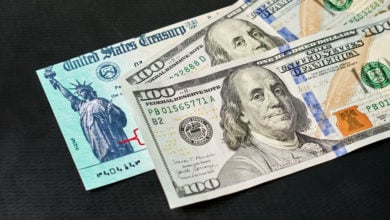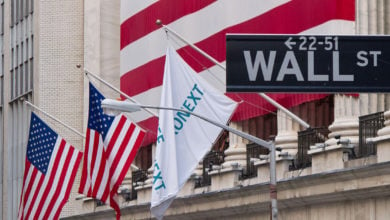The myth of “free enterprise” is dead, killed once and for all by the Crash of 2008-2009. “Get government off our backs,” the chorus sung endlessly by Wall Street’s political and media hacks over the past three decades, have suddenly become forbidden words, unspoken even on the business channels.
|
Without the massive intervention of the federal government over the past seven months and longer, the U.S. and world financial/banking system would have collapsed. Without the vast propping up of capitalism through the bloated military budget over the past six-plus decades, U.S. capitalism would have gone into deep crisis long before now.
The biggest U.S. banks are actually bankrupt today, kept on life-support by the government—particularly by the Federal Reserve System and the Department of the Treasury. While government officials, from the President to our “esteemed” senators and representatives, continually proclaim their concern for what they call “Main Street,” their number one priority is saving the biggest financial and corporate institutions. Of this, there can be no doubt.
The remaining question is not whether government intervention is necessary, but who will it benefit? Will it be the tiny minority who own and control the productive wealth of society under capitalism? Or will it be the working class, which constitutes the vast majority of the population and created through its labor this great wealth? Washington’s answer to this question has been crystal clear.
Since the economic crisis broke out in full force in September 2008, we have witnessed the most massive transfer of wealth to the already wealthy in the history of humankind. More than $8 trillion—$8,000,000,000,000—has been handed over to the biggest banks, insurance companies, investors and other corporations, most of it with no strings attached.
And “We, the People” are stuck with the bill.
Why has the government bailed out the very same financiers and institutions that triggered the crisis that has now taken the jobs and homes of millions of people? Why has the Obama administration, like the Bush regime it succeeded, let flow a river of cash to corporate giants like American International Group, the world’s largest insurance company?
AIG has received four bailouts in six months totaling $180 billion so far, and there is no end in sight. Despite the fact that it is supposed to be a company that “insures risk,” AIG has engaged in the wildest and riskiest speculation in derivatives and other schemes—forms of gambling which contribute nothing to meeting any human needs. AIG reaped huge profits—until the house of cards it helped build collapsed.
Deepening economic crisis
The capitalist economic crisis is deepening by the day, with the worst yet to come. Millions have lost their homes, pensions, health care and other necessities of life.
The official unemployment rate in February rose sharply to 8.1 percent with nearly 700,000 jobs eliminated. Unemployment was reported at over 13.4 percent for African Americans and 10.9 percent for Latinos. For young workers, the official figure is more than 20 percent; for young African American workers it is over 50 percent. The real figures are much higher, as only those actively seeking work and reporting it to the government are counted.
In the last quarter of 2008, the Gross Domestic Product declined by an astounding 6.2 percent. The GDP must increase by about 2.5 to 3 percent to just keep up with population growth.
The crisis is global. The governments of Iceland and Latvia have collapsed due to the economy. In recent weeks, street fighting has broken out in Greece, France, Cameroon and other countries as unemployment spreads. The International Monetary Fund predicts 2009 will be the first year since The Great Depression when the world GDP declines.
Not everyone is suffering, of course. The oil giant Exxon Mobil made $45.6 billion profits in 2008, the biggest profits in world history by any corporation.
Trillions for the rich—no strings attached
The headline of a Dec. 23, 2008, article in the San Jose Mercury News business section read: “Banks mum on bailout spending.” Representatives of Citibank and other banks said they had no intention of divulging how they had spent their bailout money. And, legally, they don’t have to.
Then Secretary of the Treasury Henry Paulson, former CEO of investment powerhouse Goldman-Sachs, simply told Republican and Democratic leaders in Congress that if they did not give him the authority to disperse $700 billion to the banks in any way that he saw fit, the world as we know it would come to an end within a few days. Congress acquiesced, despite a popular rebellion against it.
Every community group that gets the tiniest federal, state or private grant is required to fill out all kinds of forms showing where the money went. But banks were not even required to say what they spent the money on!
The government is subservient to the banks, not the other way around. Working-class people live under a government of, by and owned by the super-rich.
More precisely, it is a capitalist government. It is a government that represents and serves the interests of one class: the capitalist class.
What could $1 trillion buy?
What could be done instead with the trillions of dollars being turned over to the banks and other big corporate interests? With $1 trillion, 20 million new jobs could be created at $50,000 per year. And what could those workers do? Repair the degraded infrastructure—bridges, sewage and water systems, roads, and power systems, all of which need to be built or rebuilt all over the country.
Health clinics and childcare centers could be built and staffed in every neighborhood. Public schools could be re-built and stocked with school supplies, so that teachers would not have to buy them out of their own pocket. The salaries of public workers could be raised instead of being cut. Spent this way, a trillion dollars could go a long way toward ending the unemployment crisis.
For another $1 trillion, health care could be provided for everyone who doesn’t have it, More than that: a national health care system created. Four-year scholarships could be provided for all young people who wanted to go to college. Housing could be provided for every person.
There could be the funding to rebuild countries devastated by U.S. direct and indirect warfare and sanctions such as Iraq, Vietnam, Afghanistan, Palestine and Cuba. Reparations could at long last be made available to the African American community. And much more.
But these types of decisions could only come about from a different kind of government than presently exists—a government of, by and for the working class.
Underlying cause of the crisis
The current economic crisis, as all earlier depressions and recessions, has one root cause: capitalist overproduction. Capitalist overproduction has produced the boom-and-bust cycle which has characterized capitalism since it became the dominant world economic system over the past two or three centuries.
Capitalist overproduction does not mean that too much is produced in relation to the needs of the people; it means too much is produced to be sold in the market at a profit.
Throughout most of humanity’s existence, the cause of crisis was not abundance but scarcity, particularly scarcity of food. In non-capitalist societies, the overwhelming majority of production is for use, not for the market.
But in a developed capitalist society, very few produce goods or services for their own use or for that of their family. Production is for others, others we don’t know. Goods and services are distributed through the market in exchange for money. Production is for profit, not for need.
The capitalists are in competition with each other to maximize their profits. They all seek a greater share of the market. This inevitably leads to producing more than can be sold for a profit. Overproduction can cause the economy to slow down and even grind to a halt.
Today, millions of goods that people need are sitting idle in warehouses on loading docks and parking lots. Warehoused medicines and vaccines that could be helping people who are suffering or threatened with illness here and around the world will pass their expiration dates and be destroyed. Thousands of tons of food will be dumped.
The coal miner’s riddle
|
THE COAL The Coal Miner’s Riddle, from a time when many people heated their homes with coal, illustrates the dynamics of overproduction. A little girl is talking with her father, coal miner: Girl: Daddy, why is it so cold in our house? Father: Because we’ve run out of coal. Girl: Why have we run out of coal? Father: We don’t have any money to buy more. Girl: Why don’t we have any money? Father: Because I lost my job in the coal mine. Girl: Why did you lose your job? Father: Because there is too much coal. |
In the 1920s, coal miners used to tell a riddle that explained the problem of overproduction. In the riddle, a father explains to his daughter that he has lost his job precisely because they mined so much coal.
In the present crisis, housing instead of mining is the area of overproduction that has played a central role. According to a February 2009 report by the Census Bureau, there were more than 19 million empty housing units in the United States in the last quarter of 2008, over a million more than a year earlier.
But the problem is the same. As with coal in the Coal Miner’s Riddle, the more housing units become vacant, the greater the number of people who lose their homes.
Why? Because the surplus of housing in relation to the market is driving down the price of houses. In the boom period in the first half of this decade, millions of people were sold homes with low initial mortgage payments—sub-prime or adjustable rate mortgages. Brokers told prospective buyers that housing prices would continue to rise, so that they would be able to refinance their homes and meet the new payments once the higher interest rates kicked in.
But due to overproduction of houses in relation to the marketplace, the price of houses began to drop sharply in 2007. Today, 8 million families owe more on their mortgages than the market value of their homes. They are either in foreclosure or threatened with it.
Many new homebuyers in the Central Valley of California were construction workers, many of whom are Latino immigrants. When it became clear that there were too many houses on the market, housing construction began shutting down. In January 2009, reported housing starts were only 20 percent of what was reported two years earlier. Hundreds of thousands of construction workers were losing their jobs while the value of their recently purchased homes plummeted.
The crisis of overproduction is built into the capitalist system. Its inevitable resurgence shows that from any point of view other than that of the capitalists, capitalism is the most absurd system imaginable.
The mass media, nothing but a giant propaganda machine, drums a message into our heads every hour of every day that capitalism is the greatest system and will always be. This is the message communicated in a million different ways by virtually all of the institutions of society, from schools and universities to religious organizations.
But the Crash of 2008-2009 has reaffirmed Karl Marx’s scientific analysis with a vengeance. We are living in what seems to still be the early stages of the most severe economic crisis since the 1930s. The Great Depression lasted for an entire decade and was only ended by the most destructive and devastating war in world history, World War II, followed by the creation of a permanent war economy.
Since the end of World War II, U.S. war spending has totaled more than $30 trillion measured in 2008 dollars. Spending on that scale could solve the problems of global poverty. This year, real spending of past, present and future wars will easily top $1 trillion, and no cuts are proposed despite widespread suffering and need.
The astounding level of military spending over the past six decades helped to stave off the kind of crisis that gripped the capitalist system in the 1930s—until now.
What is to be done?
The Party for Socialism and Liberation puts forward a program to provide immediate relief, not for the bankers who caused the crisis, but for the millions of working people victimized by it.
The PSL demands:
- Bailout working people—employed and unemployed—not the banks
- No foreclosures, no evictions—Housing is a right
- A job or living income for every person
- Health care for all, regardless of ability to pay
- Free education through college
- No utility shutoffs
- Arrest, try and jail the bankers and corporate executives responsible for the crisis
While fighting for these immediate measures, now is the time to explain to as many people as possible that there are really only two choices for the future: The continuation of capitalism where the productive wealth is owned by a few who use it to enrich themselves through war, racism, environmental destruction and exploitation; or socialism, where the wealth of society, the means of production are socially owned and production is planned in a sustainable way to meet human need.







